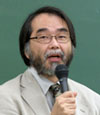1. Introduction
For people engaged in child-rearing, childcare and education, and child rehabilitation services, the accomplishment of children's well-being has great importance. The word "well-being" here means children being happy, healthy, and safe in their daily lives. In this context, Child Research Net (CRN) conducted a large-scale international collaborative survey with researchers from eight Asian countries. The theme of the survey was to explore factors nurturing "Happy and Resilient" children in Asian countries. Researchers collected and analyzed data on the conditions of children's well-being during the COVID-19 pandemic using various indicators to determine the actual status and the factors affecting children's well-being.
Although I was not directly involved in preparing and implementing this survey, I was able to review the survey results as a member of the CRN Advisory Committee and discuss the results with other committee members. Therefore, in this report, I will write down my thoughts which were inspired by such discussions.
As this survey collected a considerable variety of data, it was necessary to analyze it from multiple perspectives to comprehensively capture the outcome, which was, of course, impossible for me to do alone. Therefore, to narrow down my research object, I chose the development process of children's resilience, one of the focus points of this survey.
In addition, I noticed the potential significance of "role models" for children when analyzing the survey data. Therefore, I will discuss this significance from the viewpoint of cultural developmental psychology (Takahashi & Yamamoto 2016), my specialized area of research. From this perspective, the process of forming the self as essentially cultural can be seen as being generated in the presence of role models or in interactions with "others" who are already culturally established.
It is generally thought that the existence of role models or culturally established interactions with "others" may influence the development of cultural self-identity.
It should be noted that I did not specifically examine the effects of the COVID-19 conditions on these points of interest regarding the survey data below, because they seem to be universal phenomena for human development rather than special circumstances under the pandemic. For this reason, I did not include the impact of the pandemic in my analysis.
I found significance in such interpretations because it is possible to analyze the survey results in the context of humans' and animals' fundamental functions and evolutions, in particular the formation and development of psychology and society as a cultural entity. However, as there is insufficient space to discuss this in detail here, I included some explanatory notes at the end of this report. Please refer to them if you are interested. In addition, please refer to my previous articles (Yamamoto 2013, 2015, and 2017) for theoretical discussions regarding the definition of culture from the perspective of developmental cultural psychology (Takahashi & Yamamoto 2016).
2. Well-being, Environment, and Resilience
The critical points of this survey are summarized in the "Japan Country Report," which analyzes and discusses children's well-being from two main aspects.
One is "resilience," the children's ability residing within their inner-self. More specifically, it is the capacity to adapt and recover from adversity, and return to a normal, steady state by adjusting to inner conflicts and human relationships even after almost falling apart.*1 In this survey, the PMK-CYRM-R scale was employed to quantify the result data (please see Q6 of the Questionnaire Sheet Sample, Table 2-1-1 of the Japan Country Report); scoring was obtained from mothers' answers as the targets are young children).
Another aspect is the quality of the kind of environment supporting children's daily lives, which can be divided into the "socio-economic environment" and the "interpersonal environment." For interpersonal environment, the survey used a variety of indicators regarding the mother as a "direct environmental element" who is the closest and most influential person for children. Therefore, mothers were asked questions about their parenting attitudes (Q8), childrearing perceptions (Q16), emphasized aspects of childrearing (Q17), and so on. In addition, indicators regarding environmental variables supporting mothers were also used. These include, for example, support from childcare facilities/caregivers (Q4), splitting household chores with their spouse (Q18), and support from their spouse (Q19). The variables have been selected considering the possibility of mothers being affected in their psychological stability, such as their concerns about COVID-19 (Q1) and their level of satisfaction in daily life (Q20). Consequently, these variables will have an influence on children, as a direct/indirect interpersonal environment.
All of these variables are considered to affect children's well-being. Therefore, the KINDL scale was used to assess children's well-being(Q7). KINDL is one of the measurements to evaluate children's quality of life (QOL). In addition, other variables, such as children's facility/school attendance (Q3), academic performance (Q5), actual usage of digital media (Q9), and their play situation (Q15), were included to reveal some of the children's actual conditions.*2
Considering the construction of survey items, the following correlations were expected among these variables:
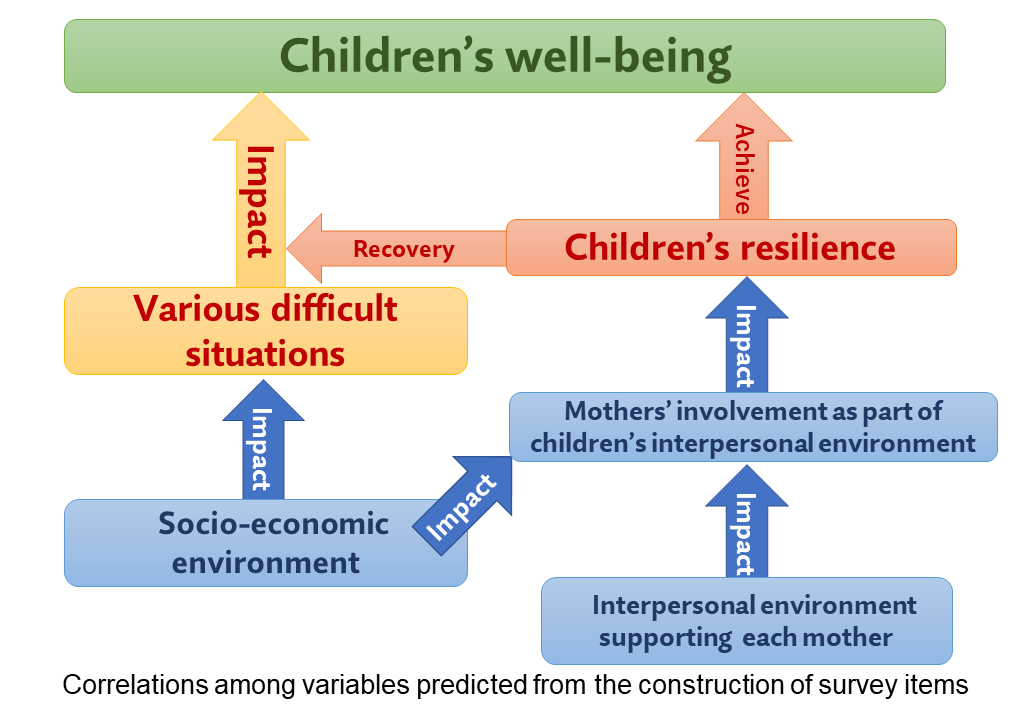
Findings could reveal that children's well-being is influenced mainly by the surrounding environment. In particular, mothers' interactions with children in childrearing are significant, which may also depend on the quality of external support they receive. However, children's well-being is not directly determined by the environment but by their capacity to cope with the environment and live proactively. Their well-being is attributed to the capacity of each child. Resilience is estimated to be an integral part of such ability. If children can develop a good level of resilience in their childhood, they will achieve adequate well-being even under challenging situations. Conversely, if children do not have adequate resilience, their well-being may deteriorate due to negative situations arising from their environment.
Therefore, children's resilience may be a more critical factor directly relevant to children's well-being rather than the surrounding environment. In this regard, the next step should be to examine the viability of that assumption and then explore a favorable environment to build children's resilience.*3
The above comments are merely based on my perspectives after reviewing the Country Report of Japan. Therefore, these comments may differ from the original intention of the CRNA collaborative research team. In this report, I will discuss the survey results and further findings based on the above perspectives, focusing on "children's resilience" and "mothers' involvement as part of the children's interpersonal environment."
3. Resilience as self-adjusting ability and mothers' responsive parenting attitudes
First, a high level of correlation between children's resilience and QOL should be focused on as one of the crucial findings of this survey. For example, among the data from Japan, correlation coefficients between QOL and resilience are highest (.626 for five-year-olds and .661 for seven-year-olds), which are close to the upper threshold of the "moderate correlation range (|.4|<r<|.7|)" (Figures 2 and 3).
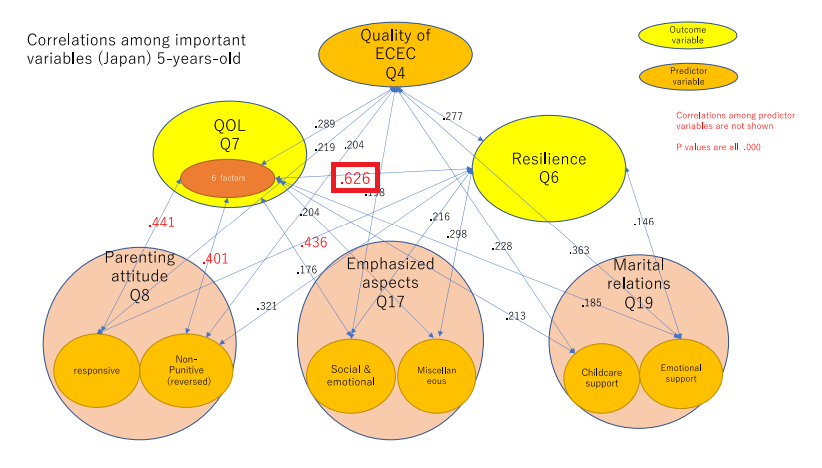 |
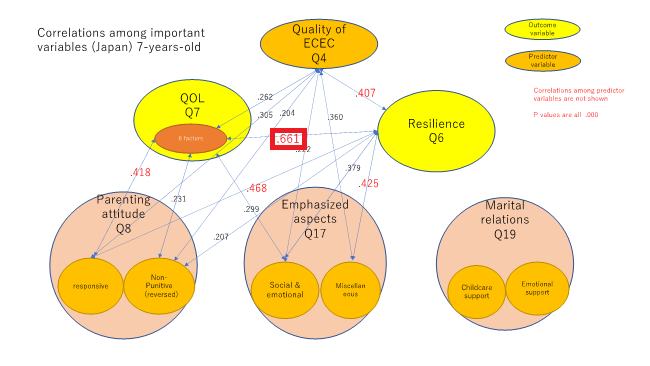 |
|
(Tomomi Sato et al., 2022) |
(Tomomi Sato et al., 2022) |
According to the "CRN International Collaborative Research Report: Survey on Children's Daily Life among 8 Asian Countries 2021," results similar to the data from Japan were confirmed in the data of eight Asian countries.*4 The data for resilience were divided into three groups of "low," "middle," and "high" and compared with their average values (Figure 4).
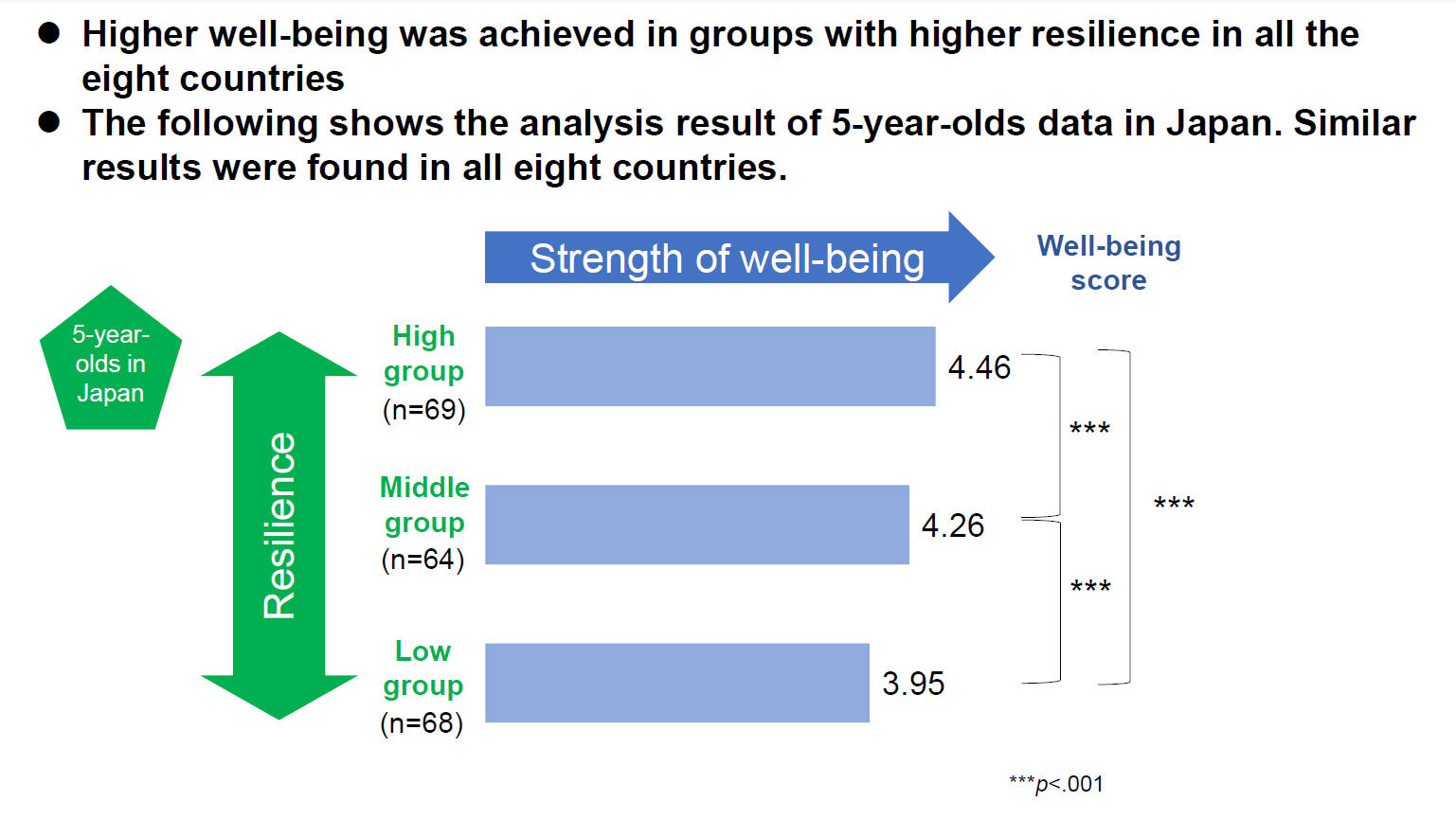
As correlation analysis is not designed to clarify cause-and-effect relationships, we cannot immediately conclude that "if children's resilience is enhanced, their QOL (well-being) will improve." However, this hypothesis seems quite viable considering the survey results. In fact, according to the China Country Report, the results of path analysis (evaluating dependencies between variables) confirm that children's resilience has a substantial impact on their QOL (.769) (Figure 5).
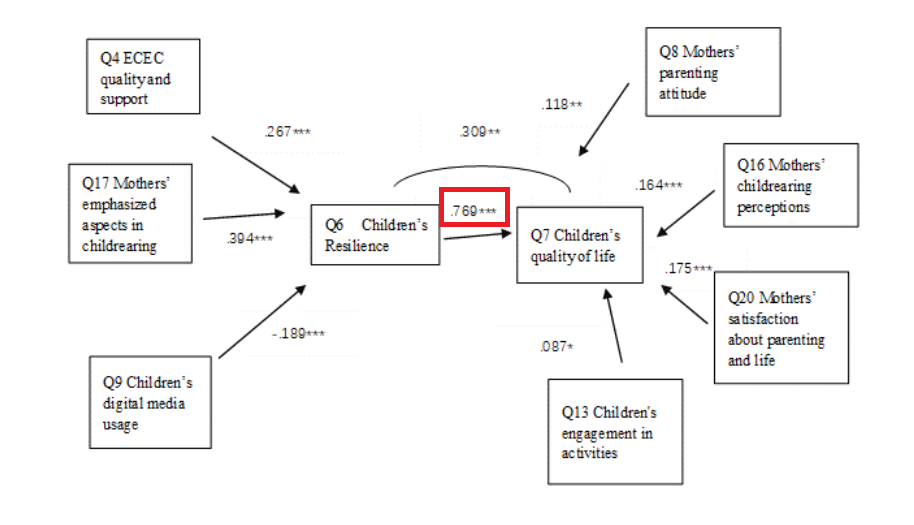
The next important step is to identify factors affecting children's resilience that strongly relate to their QOL. Of course, the strength of resilience can be determined by their innate ability, but it may also be determined by postnatal factors. Since this survey focuses on environmental factors that enhance children's well-being (QOL), I will omit the factor of innate ability from my analysis.*5
When looking at environmental factors (Figures 6 and 7) that correlate with resilience within the "moderate correlation range (|.4|<r<|.7|)," only the factor of "responsive parenting attitudes" indicates a moderate correlation (.436) among mothers of five-year-olds. In contrast, for mothers of seven-year-olds, both "responsive parenting attitudes" and "child-rearing focusing on various skills" indicate a moderate correlation (.468 and .425, respectively). In addition, the "child-rearing focusing on social and emotional skills" factor shows a close correlation (.376) to the moderate correlation range among mothers of seven-year-olds.
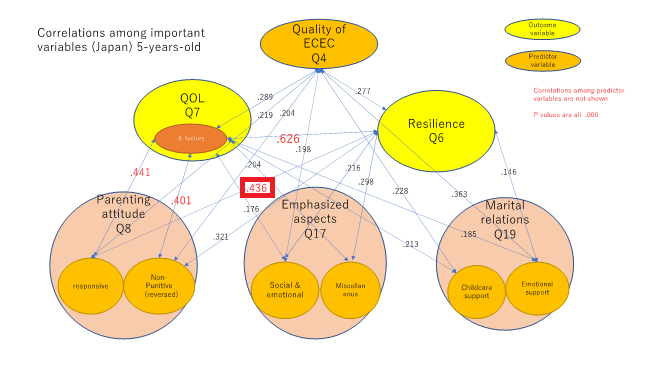 |
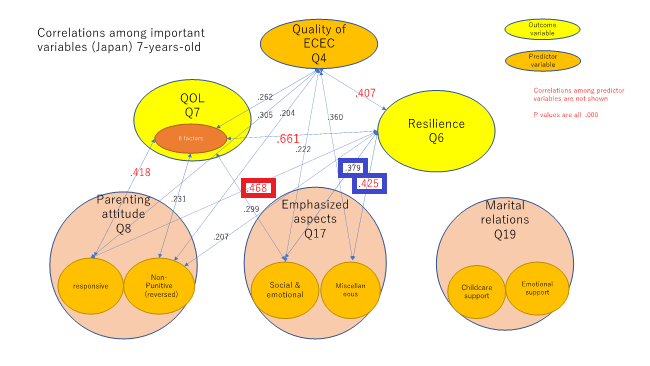 |
|
(Tomomi Sato et al., 2022) |
(Tomomi Sato et al., 2022) |
These results seem quite interesting. First of all, it is confirmed that the responsive parenting attitudes of mothers of both five- and seven-year-olds positively correlate with children's resilience. In other words, mothers' responsive parenting is related relatively deeply to the high degree of children's resilience.
Then, why does mothers' responsive parenting nurture children's resilience? I suggest the following interpretations.
As I mentioned at the beginning, resilience is the capacity to bounce back from adversity, or rather, the strength to "maintain" the attitude to recover from setbacks. As I also mentioned the fundamental functions of human beings,*1 from a view point of systems theory, resilience is also considered to be a zest for living under the mechanism of self-adjusting to the surrounding environment and difficulties when facing unstable situations due to various external factors. In this regard, resilience can be said to be a "relation adjusting ability."
*1: Living organisms have fundamental functions, such as "individual preservation" and "species preservation." These functions help maintain and restore the original state even if its balance deteriorates due to various external factors. In biology, maintaining internal physiological conditions is called "homeostasis." The Swiss psychologist Piaget researched cognitive development by applying this concept as "Schéma" (cognitive framework). He examined the establishment and maintenance of cognitive equilibrium through assimilation and accommodation processes at each developmental stage. He finally found the most satisfactory equilibrium state in the structure of logical-mathematical intelligence. A society where people interact with each other is maintained by exchanging gifts and market transactions. Fundamentally, people need to maintain equilibrium in the balance of their interactions with others, such as "indebtedness and repayment," "malice and retaliation," and "commodities and money." Individual psychological movement can be recognized as an advanced system developed based on biological mechanisms, which enables social structures to exist. Resilience is the ability to recover from setbacks caused by internal and external factors; therefore, it can be said that resilience is also one of the fundamental functions of living organisms.
*2: I have been studying with a strong interest in cultural differences in the domains of child-rearing and educational mindset. However, I do not specialize in QOL and resilience, which is said to measure children's well-being. Therefore, I cannot verify the applicability and credibility of those scales used in this survey nor sufficiently explain the concept of QOL or resilience based on previous studies. I only had rough ideas about resilience, as described in Note 1, when I wrote down my thoughts. I trust that other researchers who specialize in these fields will provide good discussions on the applicability and credibility of those measurement scales.
*3:To ensure effective motion, animals have a sensory system where they take in a stimulus from an external environment as sensory information and immediately respond to it as necessary. While its nervous system is developing, a simple reflex response to such a stimulus gradually evolves into an indirect one, processing every stimulus as information in the central nervous system. In other words, a stimulus is judged according to the situation. In this way, the cognitive structure is established, evolving from "perceptual judgment" to "thinking." Animals have two cognitive systems that actively process stimulus information. One is external cognition responding to an external environment, and the other is internal cognition detecting and accommodating physical conditions. For animals with such an advanced information processing system, a stimulus from an external environment is received and processed within the system. Therefore, response to a stimulus from an external environment may differ depending on the nature of the system. In this context, it is essential to interpret factors affecting children's well-being, not only a direct impact from an external environment but also children's resilience and other psychological systems to cope with and adjust their actions to such impact.
*4:I should point out that, after reviewing each country report, I found that a correlation between children's resilience and QOL in Taiwan is significant but very low at .177 (Figure 24 of Taiwan Country Report). I am not sure why this is so.
*5: Of course, children may be affected by their environment differently depending on their innate characteristics (such as temperament). Therefore, it is naturally essential to provide an environment suitable to their characteristics. For example, an environment suitable for children with developmental disorders may be significantly different in a qualitative sense from those with typical development. To address this issue regarding children with autism, we published our theoretical discussions in the article "From Explanation-Interpretation to Reconciliation-Symbiosis: A Theoretical Examination of Phenomenology and Perspectives of the Parties on Autism for Interactive Mutual Understanding Practice"(Yamamoto, Watanabe & Ohuchi, 2023). In addition, to promote understanding and collaboration between people with typical development and those with autism, the Developmental Research Support Center introduced a new methodology, "Gyaku SST (Social Skills Training - Reversed)," led by Dr. Tadaharu Watanabe and Dr. Masato Ouchi. Since this survey did not address such differences among children, I will omit these issues from my discussions in this report.
(To be continued in Part 2)References:
-
In English
- Child Research Net. [CRN Collaborative Research] Survey on Children's Daily Life among 8 Asian Countries 2021 Result Report.
https://www.childresearch.net/pdf/CRNA_result_report_eng.pdf - Office of Quality of Life Measures
https://www.kindl.org/english/information/ - Sato, T., Kitano, S., Fukami, T., Hoshi, M., & Sakakihara Y. (2022). [Japan] CRNA Collaborative Research for Exploring Factors Nurturing Happy and Resilient Children among Asian Countries.
https://www.childresearch.net/projects/crn_asia/2022_08.html - Takahashi, N., Yamamoto, T., Takeo, K., Oh, S. A., Pian, C., & Sato, T. (2016). East Asian children and money as a cultural tool: Dialectically understanding different cultures. Japanese Psychological Research,58, 14-27.
- Yamamoto, T. (2017). Cultural Psychology of Differences and EMS; a New Theoretical Framework for Understanding and Reconstructing Culture, Integrative Psychological and Behavioral Science, 51 (3) ,pp345-358, DOI 10.1007/s12124-017-9388-4.
- *Yamamoto T. (2013). Ambiguity and Substantiality as Essential Nature of Culture: Redefinition of Culture from the Perspectives of "Cultural Psychology of Difference." Japanese Journal of Qualitative Psychology, No.12, 44-63.
- *Yamamoto T. (2015). What and Where is Culture: The Psychology of Conflict and Symbiosis, Shinyosha.
In Japanese (* with English abstract)



